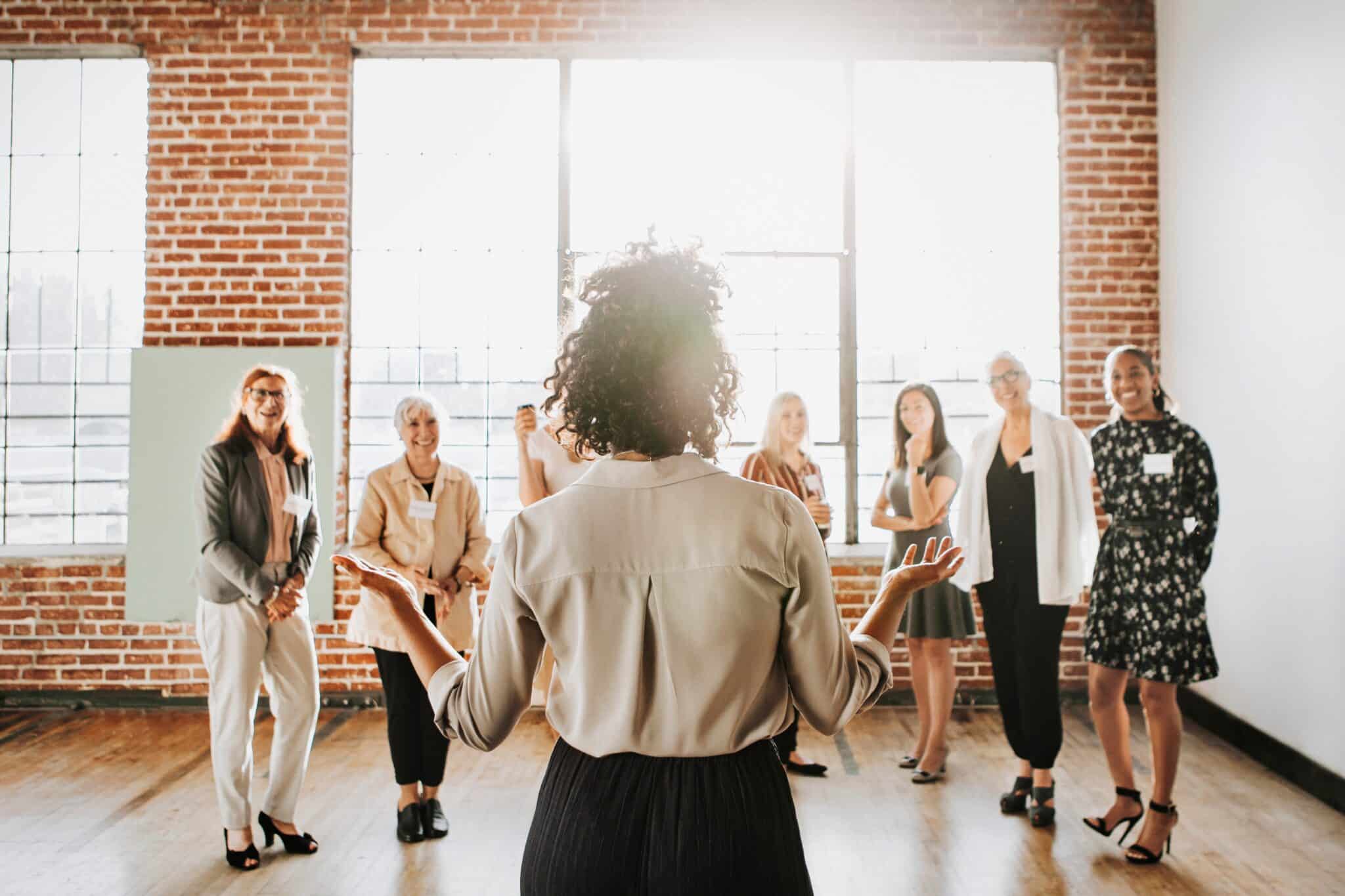The following is a transcript of our podcast conversation with Vanessa Osorio Brewster Laughlin, Brett Greene, and Dr. Robin Ballard. You can listen to the full episode on Spotify or Apple Podcasts.
Sarah
Hello, and welcome to Humans Beyond Resources, an HR podcast by Reverb, where we cover topics from culture to compliance. Reverb believes that every decision a leader makes reverberates throughout the organization. From hiring your first employee to training your entire workforce. We believe in building healthy, inclusive cultures that engage your team.
I’m your host, Sarah Wilkins. April is Neurodiversity Celebration month. In this episode, I’m chatting with three experts about how you can support and celebrate neurodiversity in your organization. Joining me are Vanessa Laughlin, Brett Greene, and Dr. Robin Ballard to share about their own experiences with neurodiversity and recommendations they have for companies when it comes to supporting and uplifting their neurodivergent employees. Vanessa is the founder of Bannister Advisors, which seeks to ease the complex emotional and logistical burdens that individuals and families confront in the face of critical circumstances across their lifespan. A native of Whidbey Island, she now lives in Seattle with her husband and two young sons. Brett is an executive coach and community builder who helps tech professionals with ADHD to thrive in life and work. His greatest passion is assisting people to live their best lives now. Dr. Ballard is a licensed clinical psychologist with experience assessing and treating children, adolescents, adults, couples, and families facing a broad array of psychological problems. She provides psychological evaluations for children adults with concerns about ADHD, autism Spectrum disorder, and co occurring conditions. This episode is a two part episode, so please keep listening for part one. Part two comes out next week. To start, I will say that we have determined a common set of terminology that we as a group are going to use today. And we also acknowledge that things can evolve and change, and there may be new terms and different ways to talk about this. We really want to focus today on how organizations can design their work environment inclusively and to consider neurodiversity. So with that in mind, I want to kick off by asking Dr. Ballard what is the term neurodiversity and what are other terms we need to know?
Dr. Ballard
Yeah, happy to start that way. So when we think about neurodiversity, we’re thinking about all the ways people can be wired up differently. And it’s a huge variety. This is not necessarily a term that’s very well defined. It’s not a diagnosis you get from the DSM, but it’s a way to think about all the different ways that people present. So classically neurodevelopmental disorders in particular would often be thought of as under the neurodivergent or neurodiversity umbrella. So things like ADHD, autism, learning disabilities, intellectual disabilities on one hand, all the way up to giftedness on the other. These are all different ways that people can get wired up in differently. So that means that they’re going to experience the world in different ways in terms of how they think, how they perceive the world, the physicality of it, in terms of how sensory information comes in. Also their emotional reactions. So when you look at everything that can fall under this neurodiversion umbrella, really, we’re talking about an awful lot of people at this point. And particularly, I’ll say, in the tech industry in the greater Seattle area, there is often quite welcoming for a variety of forms of neurodiversity. So I feel like we have a particularly high occurrence of that in this area in particular.
Sarah
And then one of the things that we talked about as a group were neurodivergent versus neurodiverse and neurotypical neurodivergence and things like that. So can any of you kind of expand a little bit more on that and how to use the terminology appropriately?
Vanessa
Broadly speaking, when we talk about diversity and difference and minorities versus majority, we talk about sort of typical maybe, we talk about other, right? So we kind of have these examples that we can reference and it’s not that different in terms of a model of how the language is used for neurodiversity. So neurodiversity is talking about the wide variety, variety and range of ways that people can, as Robin mentioned, be wired, perceive the world, communicate, understand, interact, et cetera. But then when you’re talking about an individual, the preferred term tends to be neurodivergent individual. It’s a little bit like back in the day, people would say, oh, let’s go to an ethnic restaurant someday. And what they really meant is a nontypical cuisine to the area that we’re in. And so similarly, we don’t say a diverse candidate. We would say a candidate who is representative of a different group, et cetera. So this is, again, just sort of marrying that kind of evolving language. Now, will this language be different in 5, 10, 15 years? Surely. But here’s where we’re at right now. Thanks for asking, Sarah.
Sarah
Yeah, thank you. And one of the things you had shared with me that I also saw is it’s important that this is the language we’re using, but asking a particular group or individual how they would like to be referred to is important because it varies. Right. It’s not the same for everyone.
Vanessa
That’s great. I’ll give a quick example that Robin will probably nod vigorously to, which is a no longer clinical term, meaning it’s not in the latest version of the DSM Diagnostic Statistical Manual is asperger’s. Right. Elon Musk, as some might remember, went on Saturday live and said, I have asperger’s, I’m an ASPI, et cetera. That identity may no longer have a clinical, let’s say, meaning or diagnostic significance. However, when that refers to a community of aspies, I count friends and family members who would consider themselves aspis and be proud members of that community. And so we don’t take away those types of identities or community sense of belonging or descriptors for self. So that’s a perfect example again, but you don’t want to also use that as a slur in any way. It mirrors a lot of, I think, the language and use and application for all kinds of difference that we’re encountering more openly across the board in society, organizations, and even families. Yeah.
Sarah
Thank you. So one of the topics when we were preparing, we talked about was around universal design and maybe how you’ve advised others on supporting neurodiversity in your organization. So maybe, Brett, I’ll start with you, and then we’ll add ask everyone else, how have you used universal design to help organizations support neurodiversity?
Brett
Sure. So in general, with universal design, and I think Vanessa, she may be able to go a little deeper into what she’s seen with it, but for the most part, where I’ve worked with companies around, it is really just focusing on skills that are strengths and having a strength based way of looking at roles versus, say, if a job title has 20 bullet points under what it’s supposed to be. But if you actually dove into it with somebody and found that they were excellent at seven of those things, they’re good at four or five of those, they’re bad at some, and they’re really not good at some at all. And in the world of neurodiversity, if the reason for that is a brain chemistry, then it would be better to help that person have a partner to take over those duties, or just take that out of that job role for that specific person, to help make them more fulfilled, make them be more productive, and actually make the company better, too. So when you talk about something like strengths, that’s not neurodivergence, that’s human. Right. So that makes it more universal to where it affects other people. And Vanessa had some other examples that were good, and I don’t want to take her examples.
Sarah
Yeah, Vanessa, why don’t you share?
Vanessa
Now, I’m not sure I would say they are liberally borrowed from the world of neurodiversity, nerve divergence advocacy, et cetera. But I think one of the things that I think is important to keep in mind and this is specific to explain, but also a meta reference for anyone in the audience who maybe is autistic or has a friend or family member or colleague, but precision of language is important. So being precise with the language and talking about universal design and how again, we’re talking about how does it meet the broadest needs and requirements of an individual while we’re also focusing on strengths. So an example would be and I think I actually took this from Robin which is no one has ever suffered from too clear of communication, right? No one has ever really been, let’s say, slowed down by having to use, let’s say, a small ramp versus a set of stairs to get into a building. However, the stairs are going to be a good fit for someone who’s able bodied, maybe even someone who wants to get some steps in. However, it’s going to be more broadly supportive to people who are in wheelchairs. Anyone using a stroller, someone has a dolly, someone who has a knee injury, right? So temporary or permanent kind of impairment. And so it’s sort of this idea of ramps, not stairs, right? And when you think about that from the workplace, something as simple and common as a meeting, what are the ways that you can design and be intentional with the way that you schedule a meeting, structure a meeting roles within a meeting, tools like having an agenda and follow ups, the length of the meeting itself. Maybe meetings don’t start right on the dot and don’t end right at the hour and start at the hour. Maybe they start at the hour, have a five minute grace period, content starts, and then maybe it’s a 50 minutes or 45 minutes length. Just give people time to even if they’re located on Zoom, have a break or pause in between. Those are the types of things that go from being kind of nice to have for someone who’s having a really great day, they got a great night of sleep, they’re feeling healthy, and then that has actually become essential accommodations and features of an inclusive workplace. Because then you’re supporting the people who are neurodivergent, the people who are working under a lot of stress or anxiety, and their infective function is impaired whether they have an underlying condition or not. You’re also helping the guy who was up late all night with his one year old, right, because they’ve got a fever or they’re teething or whatever the thing is. And so, again, these features are and traits you find in a lot of really high functioning organizations. They just have the added benefit of actually being, again, from a universal design perspective, broadly, broadly applicable and supportive. That’s great.
Sarah
Thank you. And Dr. Ballard, I think you had some items to add in this question as well.
Dr. Ballard
So just to take a very specific example, it’s very common when I assess, especially adults for ADHD and sort of walking through what are some of your common experiences? And for a lot of them, they’re not fundamentally misunderstanding tasks. Often the understanding is completely intact. It’s the ability to actually execute. So the sort of executive functioning that Vanessa touched on. So a really classic example of just kryptonite for the ADHD brain is you’re walking down a hallway and you catch a coworker and you say, oh, I have a couple of things to mention to you. And you rattle off a list of things and the person goes, Great. And they do understand it at that moment and they fully intend to go do the right thing with that information. But working memory is really impacted by ADHD, and working memory is your mental scratch pad. It’s how much you can hold in your head at one time and work on. So the person that you’ve just given this wonderful list to takes two steps down the hallway and it’s gone. They have the sensation of like, oh, no, I remembered one of those. And so it’s not mal intent, it’s not an inability to understand what you said or even to execute the projects, but keeping track of that information is what it’s hard. So if instead you do something like build up a company culture of, hey, I’m going to reinforce this by sending an email or letting the person who’s receiving the information say, let’s pause for a second so I can write this down. Those are the sorts of things that, again, it’s good for everybody, but it is absolutely crucial for the ADHD brain in particular.
Sarah
Yeah, thank you for sharing that example.
Vanessa
Yeah, I was nodding vigorously, so I’m proudly actually hashtag actually ADHD. So as Robin was sharing that, I was like, yes. What we as nerd divergent individuals often do is try to make it work, especially in absence, if some of us don’t get diagnosed until adulthood. So you go through your whole life wondering, why is everybody else just able to do these things effortlessly? And why is it so challenging for me? And so you do things like you carry a little notebook in your pocket or you make sure to have, for example, transcript recording allows for us to have another reinforcement. I only watch television with subtitles because it helps me not only get it in, but also retain it better. And so I think what’s nice is, with just a little bit of a shift in the culture, not even a one onto one accommodation, you can find ways to again support your people, whether they have a formal diagnosis, whether it’s a temporary, let’s say, impairment, like the new parent who’s not sleeping at night. That also impacts, if I’m correct, Robin, lack of sleep will also impact your executive function and your working memory. Right? So sometimes I use the example for people who don’t experience the world with some of the features we’re talking about. And again, there are different collections of features and traits across different diagnoses. So that there’s the adage, if you’ve met one autistic person, you’ve met one autistic person in terms of the differences. But as those clusters do come together for ADHD, very common for the working memory deficit, I would say, oh, Robin, I’m sure that’s like a pretty standard qualifier for the assessment. So all that to say, actually, I will make a comment. The chat popped up in front of my face and that made me lose my train of thought. So I had that little working memory reset, like, where am I? What am I talking about? What’s going on? Thank you for the grace of everyone. Just you’re seeing this in action. But again, I guess to wrap up, my point would be that all day long, those of us with these differences are going through not just work, but our home life and the world trying to make it work. And so a little bit of support and accommodation and change in design of our surroundings, especially where we can, like, at home and at work and hopefully school makes a huge difference. Anyone who’s experienced jet lag, maybe they’ve been traveling for 36 hours, lack of sleep plus stress, plus difference, plus time zone and, you know, gosh, I’m not just not at my best today. Well, that’s what it’s like every day for people with ADHD often. So you make it work.
Sarah
Thank you, Vanessa. Thanks for sharing.
Brett
I also have ADHD like Vanessa. We start with asking for grace and having loving kindness for what we go through. One thing that has occurred for me a lot with a lot of my individual clients and as well as a company that we just don’t think about, that can make a really big difference is how neurodivergence is really just a different operating system than neurotypical. So if we look at it more as operating systems, it’s a little bit easier to understand that, you know, that Android and iOS are different, but there’s some things that are the same. And it’s not that one’s bad or good, it’s just that they operate differently. And as soon as you have that understanding, now there’s a different conversation, now there’s a different awareness. And what a lot of us don’t realize on both sides of neurotypical or being neurodivergent is to put ourselves in the other person. One thing that can be really confusing, no matter which side of this you’re on, is that we live in our own minds and we think that’s how the world is and we think that’s how everybody’s operating. So if you have a neurodivergent brain and you see, you tell somebody, say, the hallway conversation that was mentioned earlier, and the person keeps forgetting you’re, like, wow, they just don’t care, or they’re a jerk or whatever. You make up that in a neurodivergent operating system totally makes sense, because that person would have been aware, made a choice, said yes or no. And then that thing happened. But if you’re neurotypical, it doesn’t occur for you, or you may not have even just had education that almost very few of us have ever had on neurodivergence to understand, oh, the person has low working memory, this is what it means, so they’re more likely to forget than not. And if you understand that now, you don’t think the person is a jerk, you’re like, oh, right. And you come at it in a different way that’s more positive and supportive. And that’s actually what I think is really wonderful about the diagnosis or understanding something about neurodivergence and the definitions, because it’s really like 15-20 minutes of education around this and all of a sudden it’s a different relationship. Like, if somebody two people went to lunch and one person orders something the other person thinks is weird in the way they dip their food or what they want to put mayonnaise on and they’re like in their head, that’s really weird. And the person goes, oh, I’m from this country and this is how we do it. And immediately, in 2 seconds it’s like oh okay, no big deal. And we just haven’t had that. If you say ADHD to somebody, they generally think of a fourth grade white boy running in a classroom and that’s it. You say Add and they think, oh, squirrel. Distracted. Yeah, we all get distracted and that’s the end of it. And it’s just a matter of lack of education. And what’s been awesome is between Gen Z and social media and Dr. Hallowell and everything that’s happened since the 80s. There are so many studies and books and videos and podcasts, and the awareness is so huge, especially after COVID with just our mental health, that now we’re kind of at this beginning stage to some degree of understanding and going, oh, we can just learn about this stuff. And all of a sudden we’re in a different place with it.
Sarah
Yeah, thank you for sharing that.
Remember to join us next week to listen to part two of this episode. Thank you for listening to this episode of Humans Beyond Resources. Visit reverb people.com. To find free resources, subscribe to our newsletter and connect with our team. If you haven’t already, subscribe to stay up to date on all of our upcoming episodes. We look forward to having you as part of our community.














